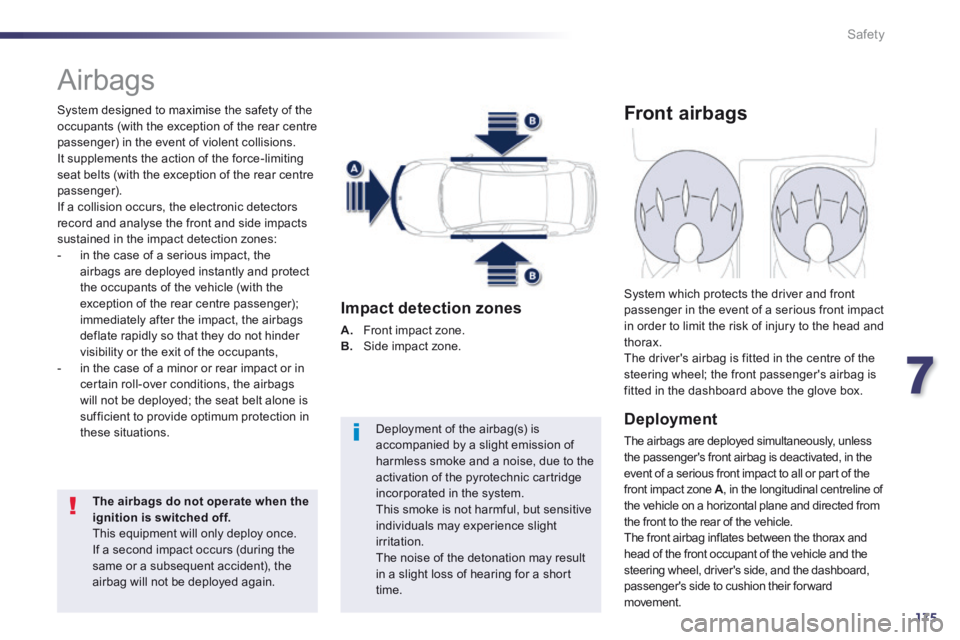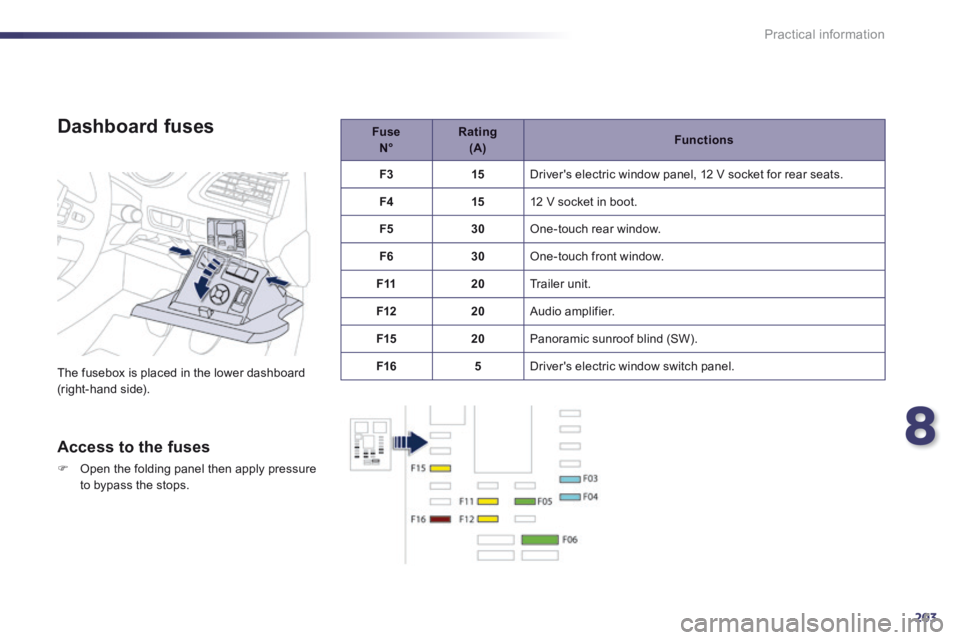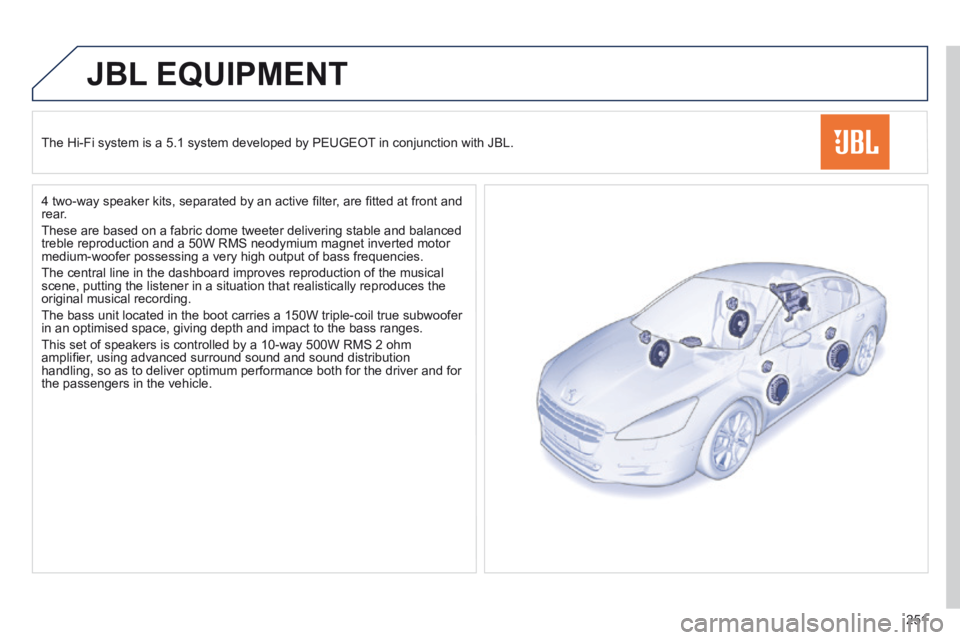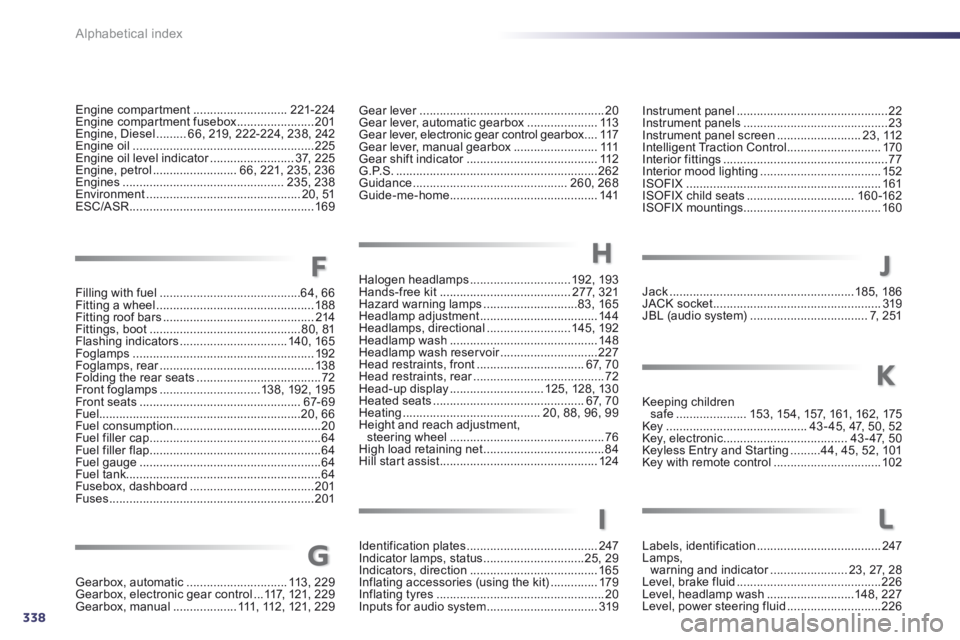2014 Peugeot 508 dashboard
[x] Cancel search: dashboardPage 89 of 352

3
87
Comfort
In order for these systems to be fully effective, follow the operation and maintenance guidelines below: If the interior temperature remains very high after the vehicle has been parked in the sun for a considerable time, first ventilate the passenger compartment for a few minutes. Place the air flow control at a sufficient level to provide an adequate renewal of air in the passenger compartment. To obtain an even air distribution, take care not to obstruct the exterior air intake grilles located at the base of the windscreen, the nozzles, the vents and the air outlets, as well as the air extractor located in the boot. Use in preference the intake of exterior air as prolonged use of the air recirculation may cause misting of the windows and side windows. Do not cover the sunshine sensor, located on the dashboard; this is used for regulation of the automatic air conditioning system. Operate the air conditioning system for 5 to 10 minutes, once or twice a month to keep it in good working order. Ensure that the passenger compartment filter is in good condition and have the filter elements replaced regularly (refer to the "Checks" section). We recommend the use of a combined passenger compartment filter. Thanks to its second special active filter, it contributes to the purification of the air breathed by the occupants and the cleanliness of the passenger compartment (reduction of allergic symptoms, bad odours and greasy deposits). The air conditioning uses power from the engine while operating. This results in an increase in the vehicle's fuel consumption. When towing at or near maximum capacity or on steep slopes in high ambient temperatures, switching off the air conditioning saves engine power and so improves towing capacity. Condensation created by the air conditioning results in a discharge of water under the vehicle when stationary, which is per fectly normal. To ensure correct operation of the air conditioning system, you are also advised to have it checked regularly. If the system does not produce cold air, do not use it and contact a PEUGEOT dealer or a qualified workshop.
Recommendations for ventilation and air conditioning
The air conditioning system does not contain chlorine and does not present any danger to the ozone layer.
Page 103 of 352

4
101
Driving
Starting-switching off the engine With a manual gearbox , put the gear lever in neutral. With an electronic gear control gearbox , put the gear lever in N . With an automatic gearbox , put the gear lever in P or N .
Insert the key in the ignition switch. Turn the key fully towards the dashboard to position 3 (Starting) . When the engine starts, release the key.
Starting using the key
Switching off using the key
Immobilise the vehicle. Turn the key fully towards you to position 1 (Stop) . Remove the key from the ignition switch.
For Diesel vehicles, in very cold weather the engine will not start until the pre-heater warning lamp has gone off.
Key left in the ignition
If the key is left in the ignition switch, there is an audible signal on opening the driver's door.
If one of the starting conditions is not met, a reminder message appears in the instrument panel screen. In some circumstances, it is necessary to turn the steering wheel slightly while pressing the "START/STOP" button to assist unlocking of the steering; a message warns you when this is needed.
If the vehicle is not immobilised, the engine will not stop. With the electronic key inside the vehicle, press the brake pedal on vehicles with automatic or electronic gear control gearbox, or depress the clutch pedal fully on vehicles with a manual gearbox and maintain pressure until the engine starts.
Starting using the electronic key
Press the " START/STOP " button.
Switching off using
the electronic key
Immobilise the vehicle.
With the electronic key inside the vehicle, press the " S TA R T/STOP " button.
The engine stops and the steering column is locked.
Accessory position
With the electronic key inside the vehicle, press the "START/STOP" button, with no action on the pedals, to switch the ignition on or off and so activate accessories.
Page 177 of 352

7
175
Safety
Airbags
System designed to maximise the safety of the occupants (with the exception of the rear centre passenger) in the event of violent collisions. It supplements the action of the force-limiting seat belts (with the exception of the rear centre passenger). If a collision occurs, the electronic detectors record and analyse the front and side impacts sustained in the impact detection zones: - in the case of a serious impact, the airbags are deployed instantly and protect the occupants of the vehicle (with the exception of the rear centre passenger); immediately after the impact, the airbags deflate rapidly so that they do not hinder visibility or the exit of the occupants, - in the case of a minor or rear impact or in certain roll-over conditions, the airbags will not be deployed; the seat belt alone is sufficient to provide optimum protection in these situations.
The airbags do not operate when the ignition is switched off.
This equipment will only deploy once. If a second impact occurs (during the same or a subsequent accident), the airbag will not be deployed again.
Deployment of the airbag(s) is accompanied by a slight emission of harmless smoke and a noise, due to the activation of the pyrotechnic cartridge incorporated in the system. This smoke is not harmful, but sensitive individuals may experience slight irritation. The noise of the detonation may result in a slight loss of hearing for a short time.
Impact detection zones
A. Front impact zone. B. Side impact zone.
Front airbags
Deployment
The airbags are deployed simultaneously, unless the passenger's front airbag is deactivated, in the event of a serious front impact to all or part of the front impact zone A , in the longitudinal centreline of A , in the longitudinal centreline of Athe vehicle on a horizontal plane and directed from the front to the rear of the vehicle. The front airbag inflates between the thorax and head of the front occupant of the vehicle and the steering wheel, driver's side, and the dashboard,
passenger's side to cushion their forward movement.
System which protects the driver and front passenger in the event of a serious front impact in order to limit the risk of injury to the head and thorax. The driver's airbag is fitted in the centre of the steering wheel; the front passenger's airbag is fitted in the dashboard above the glove box.
Page 180 of 352

178
Safety
Sit in a normal upright position. Wear a correctly adjusted seat belt. Do not leave anything between the occupants and the airbags (a child, pet, object...). This could hamper the operation of
the airbags or injure the occupants. After an accident or if the vehicle has been stolen or broken into, have the airbag systems checked. All work on the airbag system must be carried out by a PEUGEOT dealer or a qualified workshop. Even if all of the precautions mentioned are observed, a risk of injury or of minor burns to the head, chest or arms when an airbag is deployed cannot be ruled out. The bag inflates almost instantly (within a few milliseconds) then deflates within the same time discharging the hot gas via openings provided for this purpose.
Lateral airbags
Use only approved covers on the seats, compatible with the deployment the lateral airbags. For information on the range of seat covers suitable for your vehicle, you can contact a PEUGEOT dealer. Refer to the "Accessories" section. Do not fix or attach anything to the seat backs (clothing...). This could cause injury to the chest or arms if the lateral airbag is deployed. Do not sit with the upper part of the body any nearer to the door than necessary.
Front airbags
Do not drive holding the steering wheel by its spokes or resting your hands on the centre part of the wheel. Passengers must not place their feet on the dashboard. If possible, do not smoke as deployment of the airbags can cause burns or the risk of injury from a cigarette or pipe. Never remove or pierce the steering wheel or hit it violently.
For the airbags to be fully effective, observe the following safety rules:
Curtain airbags
Do not fix or attach anything to the roof. This could cause injury to the head if the curtain airbag is deployed. If fitted on your vehicle, do not remove the grab handles installed on the roof, they play a part in securing the curtain airbags.
Page 205 of 352

8
203
Practical information
Dashboard fuses
The fusebox is placed in the lower dashboard (right-hand side).
Access to the fuses
Open the folding panel then apply pressure to bypass the stops.
Fuse N° Rating (A) Functions
F3 15 Driver's electric window panel, 12 V socket for rear seats.
F4 15 12 V socket in boot.
F5 30 One-touch rear window.
F6 30 One-touch front window.
F11 20 Trailer unit.
F12 20 Audio amplifier.
F15 20 Panoramic sunroof blind (SW).
F16 5 Driver's electric window switch panel.
Page 220 of 352

218
Checks
Opening the bonnet
Opening
From inside : pull the release lever, located on the left below the dashboard, towards you.
Before doing anything under the bonnet, switch off the Stop & Start system to avoid any risk of injury resulting from an automatic change to START mode.
Closing
Lower the bonnet and release it at the end of its travel. Check that it is latched correctly.
From the outside : lift the safety catch and raise the bonnet. A bonnet strut opens the bonnet and holds it open.
Page 253 of 352

251
JBL EQUIPMENT
The Hi-Fi system is a 5.1 system developed by PEUGEOT in conjunction with JBL.
4 two-way speaker kits, separated by an active fi lter, are fi tted at front and rear.
These are based on a fabric dome tweeter delivering stable and balanced \
treble reproduction and a 50W RMS neodymium magnet inverted motor medium-woofer possessing a very high output of bass frequencies.
The central line in the dashboard improves reproduction of the musical scene, putting the listener in a situation that realistically reproduces\
the original musical recording.
The bass unit located in the boot carries a 150W triple-coil true subwoo\
fer in an optimised space, giving depth and impact to the bass ranges.
This set of speakers is controlled by a 10-way 500W RMS 2 ohm amplifi er, using advanced surround sound and sound distribution handling, so as to deliver optimum performance both for the driver and f\
or the passengers in the vehicle.
Page 340 of 352

338Alphabetical index
Filling with fuel ..........................................64, 66Fitting a wheel ...............................................188Fitting roof bars .............................................214Fittings, boot .............................................80, 81Flashing indicators ................................140, 16 5Foglamps ......................................................192Foglamps, rear ..............................................Foglamps, rear ..............................................Foglamps, rear13 8Folding the rear seats .....................................72Front foglamps ..............................138, 192, 195Front seats ................................................67- 6 9Fuel............................................................20, 66Fuel consumption ............................................20Fuel filler cap ...................................................64Fuel filler flap ...................................................64Fuel gauge ......................................................64Fuel tank..........................................................64Fusebox, dashboard .....................................201Fuses .............................................................201
Gear lever .......................................................Gear lever .......................................................Gear lever20Gear lever, automatic gearbox .....................113Gear lever, electronic gear control gearbox ....Gear lever, electronic gear control gearbox ....Gear lever, electronic gear control gearbox117Gear lever, manual gearbox .........................111Gear shift indicator .......................................Gear shift indicator .......................................Gear shift indicator112G . P. S . ............................................................262Guidance ..............................................260, 268Guide-me-home ............................................141
Halogen headlamps ..............................192, 193Hands-free kit .......................................2 7 7, 3 2 1Hazard warning lamps ............................83, 165Headlamp adjustment ...................................14 4Headlamps, directional .........................145, 192Headlamp wash ............................................148Headlamp wash reservoir .............................Headlamp wash reservoir .............................Headlamp wash reservoir227Head restraints, front ................................6 7, 7 0Head restraints, rear .......................................Head restraints, rear .......................................Head restraints, rear72Head-up display ............................125, 128, 13 0Heated seats .............................................6 7, 7 0Heating .........................................20, 88, 96, 99Height and reach adjustment, steering wheel ..............................................76High load retaining net ....................................84Hill start assist ...............................................124
Gearbox, automatic ..............................113 , 2 2 9Gearbox, electronic gear control ...117, 121, 2 29Gearbox, manual ...................111, 112, 121, 2 29
Identification plates .......................................247Indicator lamps, status ..............................25, 29Indicators, direction ......................................165Inflating accessories (using the kit) ..............179Inflating tyres ..................................................20Inputs for audio system .................................319
Labels, identification .....................................247Lamps, warning and indicator .......................warning and indicator .......................warning and indicator23, 27, 28Level, brake fluid ...........................................226Level, headlamp wash ..........................148, 2 27Level, power steering fluid ............................226
Jack .......................................................185, 18 6JACK socket ..................................................319JBL (audio system) ...................................7, 2 51
Instrument panel .............................................22Instrument panels ...........................................23Instrument panel screen .........................2 3 , 112Intelligent Traction Control ............................170Interior fittings .................................................77Interior mood lighting ....................................152ISOFIX ..........................................................161ISOFIX child seats ................................160 -162ISOFIX mountings.........................................160
Keeping children safe .....................153, 154, 157, 161, 162, 175Key ..........................................43 - 45, 47, 50, 52Key, electronic .....................................4 3 - 4 7, 5 0Keyless Entry and Starting .........44, 45, 52, 101Key with remote control ................................102
FH
G
IL
J
K
Engine compartment ............................221-224Engine compartment fusebox .......................201Engine, Diesel .........66, 219, 222-224, 238, 242Engine oil ......................................................225Engine oil level indicator .........................Engine oil level indicator .........................Engine oil level indicator3 7, 2 2 5Engine, petrol .........................66, 221, 235, 236Engines ................................................235, 238Environment ..............................................2 0 , 51ESC/ASR .......................................................169